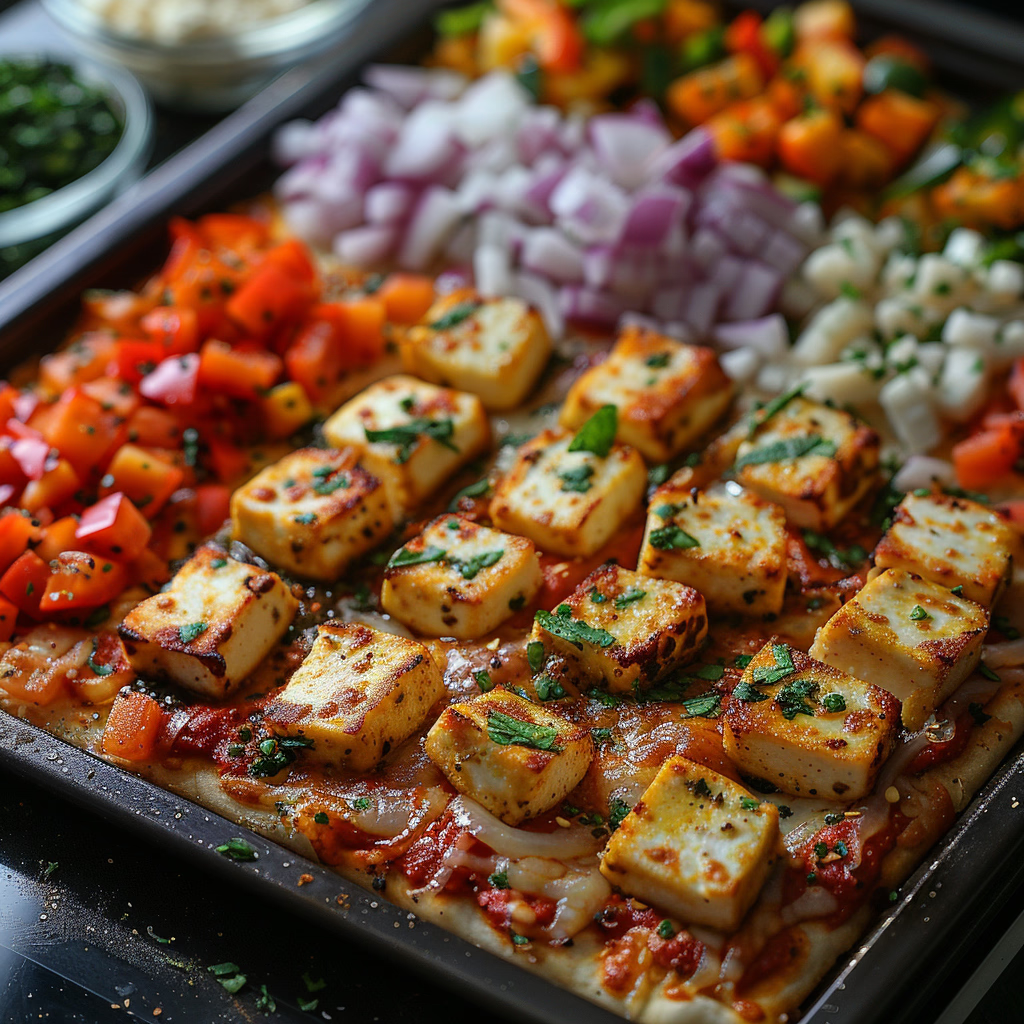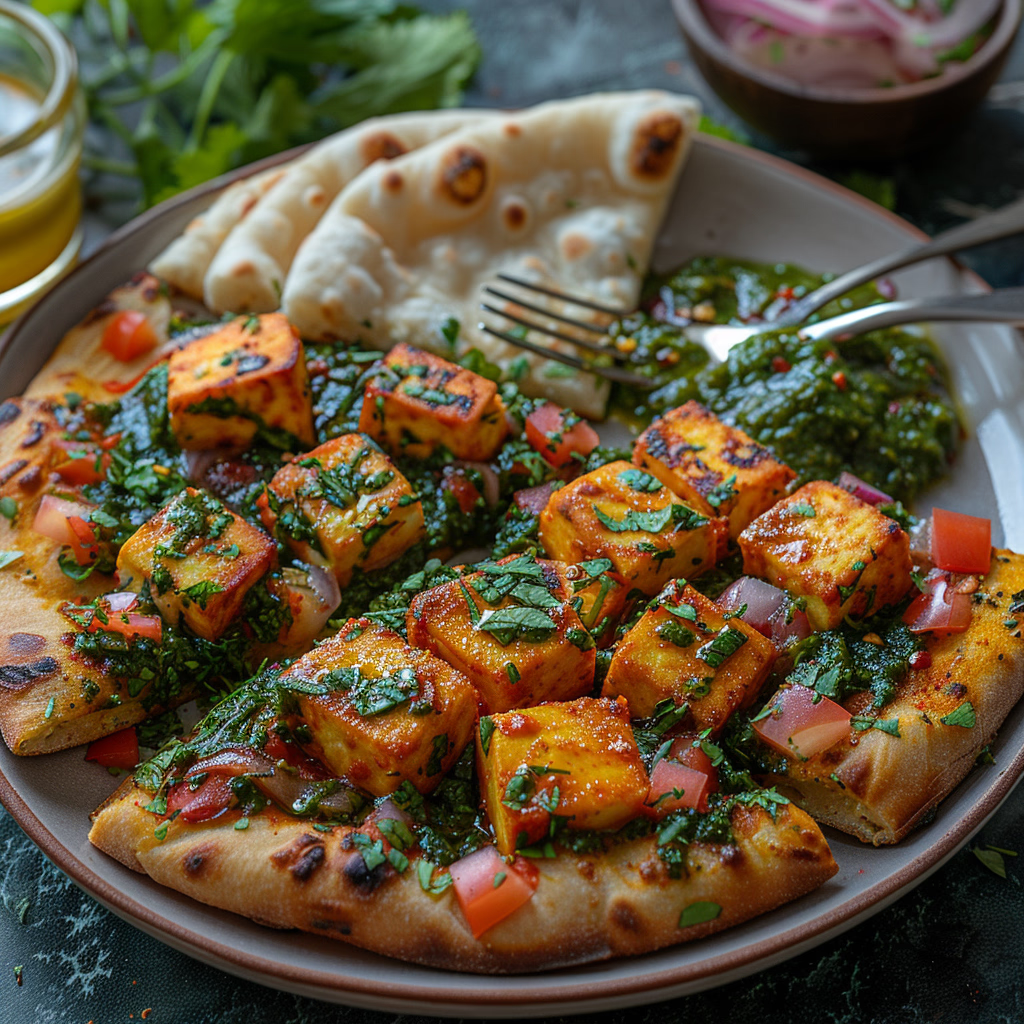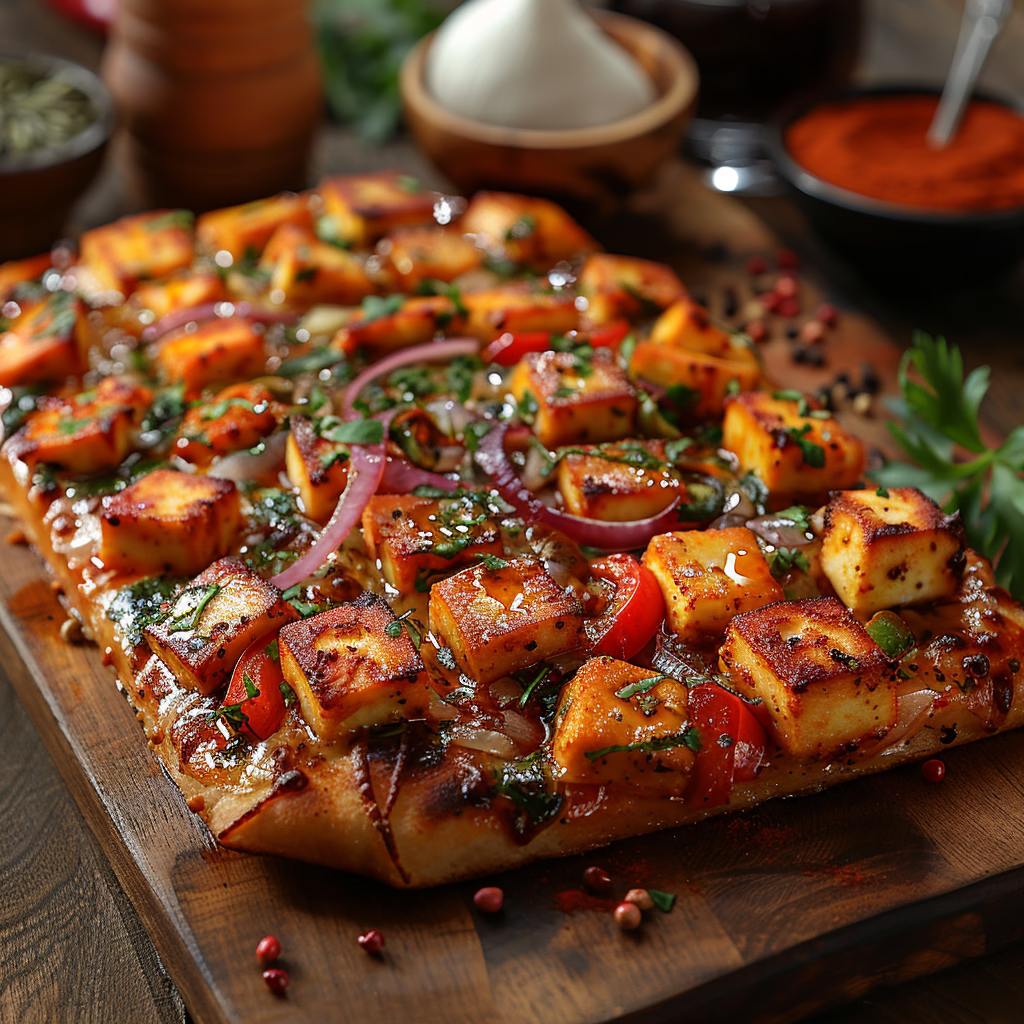Pizza is a universally loved dish, but sometimes, the traditional ingredients just aren’t available or suitable for everyone. One such situation often arises with cheese, especially mozzarella, a cornerstone of many pizzas. But what if you could switch things up? What if you could use paneer, a beloved Indian dairy product, instead of traditional cheese? This article dives into that very question. We’ll explore how paneer compares to regular cheese, its benefits and challenges as a pizza topping, and how to incorporate it into both classic and fusion pizza recipes.
Let’s start with understanding what paneer is and why it might be a suitable substitute for cheese.
Part 1: Introduction to Using Paneer in Pizza
What is Paneer and How is it Different from Cheese?
Paneer, often called Indian cottage cheese, is a fresh, non-aged cheese made by curdling milk with a food acid like lemon juice or vinegar. Unlike mozzarella, which is known for its stretchy, gooey texture when melted, paneer retains its firm and crumbly structure even when heated. This unique trait makes it distinct from the meltable cheeses typically used in pizzas.
Unlike processed cheese, paneer is completely natural and often homemade, especially in Indian households. Its mild, creamy flavor makes it a versatile ingredient, blending well with various cuisines and dishes.
Why Consider Paneer as a Substitute for Pizza Cheese?
There are several reasons you might think of replacing traditional pizza cheese with paneer. For starters, paneer is readily available in many regions where mozzarella may not be. Moreover, it appeals to those seeking a healthier, protein-rich alternative. It’s also a lifesaver for those who prefer a less greasy option or want to add a unique fusion twist to their pizza.
Paneer may not melt like mozzarella, but it creates a delightful texture and flavor profile, making it an intriguing choice for pizza lovers who enjoy experimenting. Whether you’re out of cheese or simply curious to try something new, paneer might just be the perfect replacement.
Can I Use Paneer Instead of Cheese in Pizza?
Pizza is a universally loved dish, but sometimes, the traditional ingredients just aren’t available or suitable for everyone. One such situation often arises with cheese, especially mozzarella, a cornerstone of many pizzas. But what if you could switch things up? What if you could use paneer, a beloved Indian dairy product, instead of traditional cheese? This article dives into that very question. We’ll explore how paneer compares to regular cheese, its benefits and challenges as a pizza topping, and how to incorporate it into both classic and fusion pizza recipes.
Let’s start with understanding what paneer is and why it might be a suitable substitute for cheese.
Part 1: Introduction to Using Paneer in Pizza
What is Paneer and How is it Different from Cheese?
Paneer, often called Indian cottage cheese, is a fresh, non-aged cheese made by curdling milk with a food acid like lemon juice or vinegar. Unlike mozzarella, which is known for its stretchy, gooey texture when melted, paneer retains its firm and crumbly structure even when heated. This unique trait makes it distinct from the meltable cheeses typically used in pizzas.
Unlike processed cheese, paneer is completely natural and often homemade, especially in Indian households. Its mild, creamy flavor makes it a versatile ingredient, blending well with various cuisines and dishes.
Why Consider Paneer as a Substitute for Pizza Cheese?
There are several reasons you might think of replacing traditional pizza cheese with paneer. For starters, paneer is readily available in many regions where mozzarella may not be. Moreover, it appeals to those seeking a healthier, protein-rich alternative. It’s also a lifesaver for those who prefer a less greasy option or want to add a unique fusion twist to their pizza.
Paneer may not melt like mozzarella, but it creates a delightful texture and flavor profile, making it an intriguing choice for pizza lovers who enjoy experimenting. Whether you’re out of cheese or simply curious to try something new, paneer might just be the perfect replacement.
Part 2: Paneer vs. Traditional Pizza Cheeses
Paneer vs. Mozzarella: Key Differences
When exploring the question, Can I use paneer instead of cheese in pizza?, the comparison between paneer and mozzarella is critical. Mozzarella is prized for its meltability, creating that gooey, stretchy texture synonymous with traditional pizzas. Paneer, on the other hand, holds its shape even when heated, offering a firmer bite.
While mozzarella boasts a mild, buttery flavor, paneer is creamier with a subtle tang, making it a distinctive alternative. Mozzarella’s melting properties stem from its high moisture and fat content, whereas paneer’s structure is due to its fresh, non-aged composition. These differences mean that paneer won’t provide the same visual or textural appeal but can be an excellent choice for those seeking a unique pizza experience.
How Paneer Behaves in High Heat vs. Melting Cheeses
Unlike mozzarella, paneer doesn’t melt. Instead, it softens and absorbs flavors, making it ideal for spice-infused or curry-based pizzas. Paneer’s high protein content allows it to withstand heat without losing its structure. This makes it a standout ingredient for fusion pizzas that combine traditional and Indian elements.
Paneer may not stretch like cheese, but it adds a rich creaminess, complementing robust toppings like capsicum, onions, and spicy sauces. Whether baked in a wood-fired oven or a conventional setup, paneer remains a satisfying and flavorful topping.
Nutritional Comparison of Paneer and Cheese
One compelling reason to consider paneer as a substitute is its nutritional profile. Paneer is naturally lower in fat and calories compared to mozzarella, making it a healthier choice. Its high protein content makes it an excellent option for those looking to boost their nutrient intake.
However, paneer contains less calcium than traditional cheeses, so it may not fully meet the needs of those relying on cheese for their calcium intake. Still, for those prioritizing low-fat, high-protein alternatives, paneer is a worthy contender.
For more creative pizza ideas featuring paneer, consider checking the post “What Kind of Pizza is in India?“.
Part 3: Benefits of Using Paneer in Pizza
Health Benefits: Lower Fat and High Protein Content
One standout advantage of using paneer is its nutritional benefits. Unlike traditional pizza cheeses, paneer is low in fat and rich in protein, making it a healthier choice for health-conscious individuals. For vegetarians, it offers an excellent source of essential amino acids and other nutrients.
Additionally, paneer is naturally gluten-free and free from artificial additives, making it a clean-eating choice for pizzas. For those aiming to reduce their calorie intake without compromising flavor, paneer provides a nutritious solution.
Unique Flavor Profile Paneer Brings to Pizza
The creamy yet mild flavor of paneer allows it to pair beautifully with bold, spicy, or tangy toppings. Whether marinated in spices or used plain, it adds a distinctive depth to the overall flavor of the pizza. Paneer can absorb sauces and spices, making it a versatile ingredient for creating a variety of flavor profiles.
For instance, paneer complements Indian spices like cumin, coriander, and garam masala, which can be incorporated into the sauce or as a topping. This opens the door to unique fusion recipes that merge Indian and Italian cuisines seamlessly.
Suitability for Indian and Fusion Pizza Recipes
Paneer shines in Indian-style pizzas, where it pairs effortlessly with naan bases or curry-infused sauces. Topping combinations like paneer tikka, mint chutney, and capsicum create a perfect balance of flavors.
Fusion pizzas featuring paneer can cater to those who love experimenting with their food. Whether it’s a butter chicken-inspired pizza or a tandoori paneer delight, paneer elevates the dish with its rich texture and adaptability.
Part 4: Challenges of Using Paneer in Pizza
Lack of Meltability and Texture Differences
One of the biggest hurdles when using paneer in pizza is its inability to melt like traditional cheeses. While mozzarella creates that signature gooey stretch, paneer retains its firm structure even at high temperatures. This characteristic may not appeal to those who prefer the classic cheesy pull of pizza.
However, this lack of meltability can be addressed creatively. Marinating paneer in flavorful spices or sauces ensures it complements the pizza’s toppings and adds a unique twist. For example, a tandoori paneer marinade enhances both taste and texture, compensating for its non-melting nature.
Managing Paneer’s Flavor for Balance
Paneer’s mild flavor is both a blessing and a challenge. Without proper seasoning or pairing, it might taste bland, especially when replacing more flavorful cheeses. To balance its taste, consider infusing it with spices, herbs, or marinades before adding it to your pizza. Popular options include tikka masala, pesto, or even a light garlic butter coating.
Pairing paneer with bold toppings like onions, bell peppers, or olives can also help create a harmonious flavor profile. A well-thought-out combination of toppings and spices can transform the pizza into a delightful fusion of textures and flavors.
Tips to Prepare Paneer for Optimal Pizza Use
To get the best results, slice paneer into small cubes or thin strips. Pre-cooking it slightly, either by grilling or pan-searing, enhances its texture and allows it to absorb more flavor. Additionally, spreading a layer of flavorful sauce beneath the paneer helps create a cohesive taste in every bite.
For more tips on balancing bold flavors, check out this guide: “Indian Pizza Flavors and Fusion Delights“.
Part 5: How to Make Pizza with Paneer

Choosing the Right Base and Sauce for Paneer Pizza
The foundation of any great pizza starts with the base and sauce. When using paneer, consider experimenting with bases like naan or whole-wheat crusts to add an Indian flair. For the sauce, think beyond traditional tomato. A curry-infused tomato base or a spiced yogurt spread works wonderfully with paneer, elevating the pizza to a fusion masterpiece.
Paneer also pairs well with pesto, butter masala, or even tangy mint chutney. These sauces infuse the dish with rich, complementary flavors that enhance paneer’s mild creaminess.
Recipe 1: Classic Paneer Tikka Pizza
For a crowd-pleasing option, try a paneer tikka pizza. Here’s a quick recipe:
- Marinate cubed paneer in yogurt, chili powder, turmeric, and garam masala.
- Spread a spiced tomato sauce over a naan or pizza base.
- Add your marinated paneer, sliced onions, and bell peppers.
- Sprinkle a mix of mozzarella and paneer for a balanced texture.
- Bake at 425°F (220°C) for 12-15 minutes, and garnish with fresh cilantro before serving.
Recipe 2: Indian Spiced Paneer and Vegetable Pizza
For a vegetable-packed twist:
- Prepare a curry-infused sauce with garlic, ginger, and tomatoes.
- Spread the sauce over your favorite pizza base.
- Top with thinly sliced paneer, spinach, corn, and red onions.
- Bake until the crust is golden, and finish with a drizzle of mint chutney or olive oil.
Paneer’s versatility makes it the star of these creative pizzas. While it’s a different experience than traditional cheese, the results are undeniably delicious.
For more creative recipes, explore TastyFables’ range of unique dishes. If you’re in the mood for fusion ideas, their “What Is an Indian Style Pizza?” article is a must-read.
Part 6: Paneer in Fusion Pizza Recipes
Paneer with Naan Base: An Indian Twist
For those who love combining traditional flavors with modern twists, paneer works wonderfully with a naan base. Naan’s soft, chewy texture pairs beautifully with the creamy yet firm texture of paneer. To enhance the fusion, spread a spiced tomato or butter masala sauce over the naan before adding paneer cubes.
Toppings like roasted bell peppers, onions, and fresh cilantro bring the pizza together. Baking this creation at a high temperature ensures the naan base is crispy on the outside but tender inside, making it a delightful meal for anyone wondering, Can I use paneer instead of cheese in pizza?.
This style of pizza is perfect for Indian food enthusiasts who want to enjoy familiar flavors in a new format. It’s also a great way to introduce family and friends to fusion cuisine.
Fusion Flavors: Combining Paneer with Global Toppings
Paneer’s versatility means it can easily be incorporated into international-style pizzas. For a Mediterranean-inspired twist, pair paneer with toppings like olives, sun-dried tomatoes, and fresh basil. If you’re in the mood for something spicier, consider a Mexican-inspired pizza featuring paneer, jalapeños, and a chipotle-infused sauce.
The key to successful fusion pizzas lies in balancing flavors. Paneer’s mild profile complements bold and spicy toppings, while its texture adds a unique element that sets these pizzas apart. So, whether you’re crafting an Indian-Mexican hybrid or a Mediterranean-Indian delight, paneer is the perfect bridge between cuisines.
For more creative ways to reimagine pizza, check out the article “What Is an Indian Style Pizza?“.
Part 7: FAQs About Using Paneer in Pizza

Can Paneer Fully Replace Cheese in All Pizzas?
Paneer can replace cheese in many recipes, but it may not be suitable for every pizza style. If you’re aiming for that classic stretchy cheese pull, paneer won’t deliver. However, it excels in pizzas that emphasize bold flavors or use unique bases like naan or whole-wheat crusts. The firm texture and creamy taste of paneer make it ideal for creating distinctive, fusion-style pizzas.
What Types of Paneer Work Best?
Fresh, homemade paneer is often the best choice for pizza. Its soft texture and clean flavor allow it to absorb marinades and spices more effectively. Pre-packaged paneer is also an option, but ensure it’s not overly firm or dry, as this can affect the overall texture of the pizza.
How to Store Paneer for Later Use in Pizzas?
Paneer can be stored in an airtight container in the refrigerator for up to a week. If you plan to use it in multiple recipes, consider marinating portions beforehand to save time and enhance flavor. For longer storage, freeze paneer in individual portions, ensuring it’s well-wrapped to prevent freezer burn.
Using paneer opens up countless possibilities for creative and flavorful pizzas. Whether you’re a traditionalist or an adventurer in the kitchen, trying paneer as a cheese substitute is worth exploring.
Part 8: Creative Tips for Using Paneer in Pizza
Marinate Paneer for Extra Flavor
If you’re asking yourself, Can I use paneer instead of cheese in pizza?, one way to make paneer shine is by marinating it beforehand. A quick marinade of yogurt, spices like paprika or cumin, and a dash of lemon juice can transform plain paneer into a flavor-packed topping. Let the paneer soak for at least 30 minutes to ensure it absorbs the spices.
Marinated paneer pairs particularly well with fusion-style pizzas. For example, a paneer tikka marinade works beautifully with a tomato-based pizza sauce, while a pesto marinade complements Mediterranean flavors. These added layers of flavor make paneer a delightful alternative to traditional cheese.
Experiment with Texture and Presentation
Since paneer doesn’t melt like mozzarella, focus on enhancing its texture and visual appeal. Cutting paneer into small cubes or thin slices ensures it cooks evenly and integrates well with the toppings. For a crispier bite, lightly pan-fry or grill the paneer before adding it to your pizza.
Presentation also matters. Arrange paneer evenly across the pizza, interspersing it with colorful toppings like bell peppers, cherry tomatoes, or fresh basil leaves. This not only boosts the visual appeal but also ensures every bite is flavorful and satisfying.
Part 9: Why Paneer is a Great Choice for Pizza
A Healthier Alternative to Traditional Cheese
Paneer is often hailed as a healthier substitute for traditional cheeses. Rich in protein and low in fat, it’s a fantastic option for anyone looking to enjoy pizza without guilt. Additionally, it’s a great source of essential nutrients like calcium and phosphorus, making it a wholesome choice for families.
For health-conscious individuals or those managing dietary restrictions, paneer provides the creaminess of cheese without the high calorie and fat content. If you’ve ever wondered, Can I use paneer instead of cheese in pizza?, its nutritional benefits alone make it worth trying.
A Versatile Ingredient for Fusion Flavors
Another reason paneer is a stellar choice is its versatility. It seamlessly integrates with a wide range of cuisines and toppings, from Indian spices to Mediterranean herbs. Its ability to absorb flavors means you can experiment with endless combinations.
Paneer works equally well in traditional-style pizzas and experimental creations, making it a favorite for home cooks who enjoy exploring new recipes. Whether you’re crafting an authentic Indian-inspired dish or simply want to switch up your usual pizza night, paneer offers a unique and satisfying alternative.

